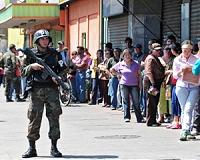| . |  |
. |
Lucknow (AFP) March 4, 2010 Sixty-three people, all of them women and children, were crushed to death in a stampede on Thursday at a temple in northern India where a crowd had gathered for a religious festival. The stampede was triggered when an under-construction gate collapsed on the crowd as people surged forward to collect free food and clothes from a local holy man in northern Uttar Pradesh state, police said "We have now counted all the bodies and they include 37 children and 26 women who had come to collect free gifts," assistant superintendent of police S.P. Pathak told AFP by phone from the disaster site. The accident occured at the Hindu Ram Janki temple in Pratapgarh, 650 kilometres (400 miles) southeast of New Delhi, where up to 10,000 devotees of holy man Swami Kripaluji Maharaj had gathered, police said. According to his website, the Maharaj runs a charitable trust which sets up schools, temples and hospitals and operates five large ashrams (hermitages), including one in the United States. Stampedes at religious events in India are common as large numbers of excited worshippers pack into congested areas. Panic can spread quickly and, with few safety regulations in place, the result is often lethal. The deadliest recent incident was in October 2008 when about 220 people died near a temple inside Jodhpur's famous Mehrangarh Fort. More than 25,000 worshippers had rushed towards the hill-top shrine to join in an auspicious moment for offering prayers at the start of Navaratri, a nine-day Hindu festival. That stampede appeared to have started when a wall along the narrow path leading up to the temple collapsed, killing several people. Hundreds of people were trampled and suffocated to death in the ensuing panic. Pilgrimages and festivals are a part of daily life in India and the vast majority of Indians, across the entire social spectrum, will participate regularly. The choice is vast, as is the size of crowds, which can range from just several hundred pilgrims to the tens of millions who flock to the massive Kumbh Mela festivals at the confluence of the holy Ganges and Yamuna rivers. In most cases, crowd management measures are rudimentary, or even non-existent, and police action has often been blamed for exacerbating panic when things go wrong.
Share This Article With Planet Earth
Related Links Bringing Order To A World Of Disasters A world of storm and tempest When the Earth Quakes
 Troop influx reins in Chile looting
Troop influx reins in Chile lootingConcepcion, Chile (AFP) March 3, 2010 Thousands of troops sent in to quell unrest restored calm Wednesday in Chile's second largest city with the help of a strict curfew, four days after a massive earthquake and tsunami. The government raised the toll from Saturday's 8.8-magnitude quake to 799, as soldiers patrolled overnight on the streets of Concepcion to stop rampant looting and isolated acts of arson that threatened to ruin ... read more |
|
| The content herein, unless otherwise known to be public domain, are Copyright 1995-2010 - SpaceDaily. AFP and UPI Wire Stories are copyright Agence France-Presse and United Press International. ESA Portal Reports are copyright European Space Agency. All NASA sourced material is public domain. Additional copyrights may apply in whole or part to other bona fide parties. Advertising does not imply endorsement,agreement or approval of any opinions, statements or information provided by SpaceDaily on any Web page published or hosted by SpaceDaily. Privacy Statement |